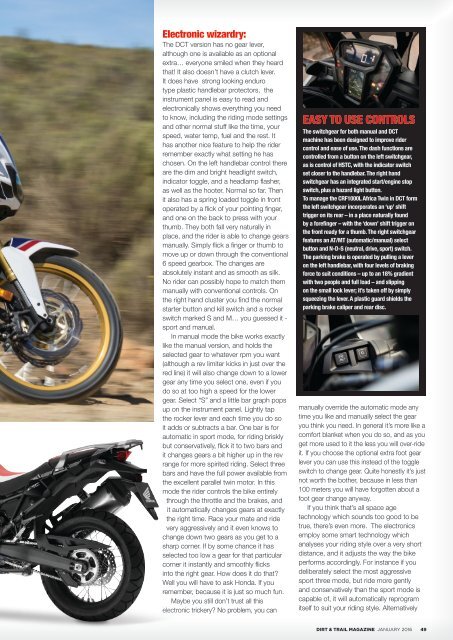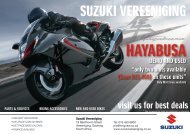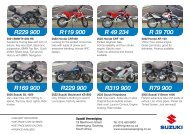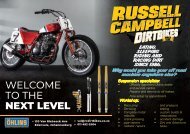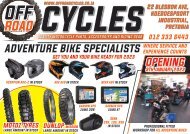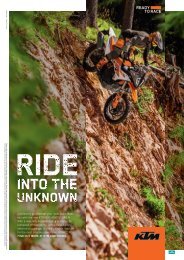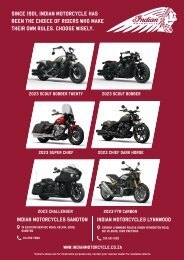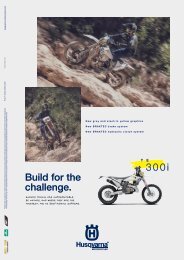Create successful ePaper yourself
Turn your PDF publications into a flip-book with our unique Google optimized e-Paper software.
Electronic wizardry:<br />
The DCT version has no gear lever,<br />
although one is available as an optional<br />
extra… everyone smiled when they heard<br />
that! It also doesn’t have a clutch lever.<br />
It does have strong looking enduro<br />
type plastic handlebar protectors, the<br />
instrument panel is easy to read and<br />
electronically shows everything you need<br />
to know, including the riding mode settings<br />
and other normal stuff like the time, your<br />
speed, water temp, fuel and the rest. It<br />
has another nice feature to help the rider<br />
remember exactly what setting he has<br />
chosen. On the left handlebar control there<br />
are the dim and bright headlight switch,<br />
indicator toggle, and a headlamp flasher,<br />
as well as the hooter. Normal so far. Then<br />
it also has a spring loaded toggle in front<br />
operated by a flick of your pointing finger,<br />
and one on the back to press with your<br />
thumb. They both fall very naturally in<br />
place, and the rider is able to change gears<br />
manually. Simply flick a finger or thumb to<br />
move up or down through the conventional<br />
6 speed gearbox. The changes are<br />
absolutely instant and as smooth as silk.<br />
No rider can possibly hope to match them<br />
manually with conventional controls. On<br />
the right hand cluster you find the normal<br />
starter button and kill switch and a rocker<br />
switch marked S and M… you guessed it -<br />
sport and manual.<br />
In manual mode the bike works exactly<br />
like the manual version, and holds the<br />
selected gear to whatever rpm you want<br />
(although a rev limiter kicks in just over the<br />
red line) it will also change down to a lower<br />
gear any time you select one, even if you<br />
do so at too high a speed for the lower<br />
gear. Select “S” and a little bar graph pops<br />
up on the instrument panel. Lightly tap<br />
the rocker lever and each time you do so<br />
it adds or subtracts a bar. One bar is for<br />
automatic in sport mode, for riding briskly<br />
but conservatively, flick it to two bars and<br />
it changes gears a bit higher up in the rev<br />
range for more spirited riding. Select three<br />
bars and have the full power available from<br />
the excellent parallel twin motor. In this<br />
mode the rider controls the bike entirely<br />
through the throttle and the brakes, and<br />
it automatically changes gears at exactly<br />
the right time. Race your mate and ride<br />
very aggressively and it even knows to<br />
change down two gears as you get to a<br />
sharp corner. If by some chance it has<br />
selected too low a gear for that particular<br />
corner it instantly and smoothly flicks<br />
into the right gear. How does it do that?<br />
Well you will have to ask Honda. If you<br />
remember, because it is just so much fun.<br />
Maybe you still don’t trust all this<br />
electronic trickery? No problem, you can<br />
EASY TO USE CONTROLS<br />
The switchgear for both manual and DCT<br />
machine has been designed to improve rider<br />
control and ease of use. The dash functions are<br />
controlled from a button on the left switchgear,<br />
as is control of HSTC, with the indicator switch<br />
set closer to the handlebar. The right hand<br />
switchgear has an integrated start/engine stop<br />
switch, plus a hazard light button.<br />
To manage the CRF1000L Africa Twin in DCT form<br />
the left switchgear incorporates an ‘up’ shift<br />
trigger on its rear – in a place naturally found<br />
by a forefinger – with the ‘down’ shift trigger on<br />
the front ready for a thumb. The right switchgear<br />
features an AT/MT (automatic/manual) select<br />
button and N-D-S (neutral, drive, sport) switch.<br />
The parking brake is operated by pulling a lever<br />
on the left handlebar, with four levels of braking<br />
force to suit conditions – up to an 18% gradient<br />
with two people and full load – and slipping<br />
on the small lock lever; it’s taken off by simply<br />
squeezing the lever. A plastic guard shields the<br />
parking brake caliper and rear disc.<br />
manually override the automatic mode any<br />
time you like and manually select the gear<br />
you think you need. In general it’s more like a<br />
comfort blanket when you do so, and as you<br />
get more used to it the less you will over-ride<br />
it. If you choose the optional extra foot gear<br />
lever you can use this instead of the toggle<br />
switch to change gear. Quite honestly it’s just<br />
not worth the bother, because in less than<br />
100 meters you will have forgotten about a<br />
foot gear change anyway.<br />
If you think that’s all space age<br />
technology which sounds too good to be<br />
true, there’s even more. The electronics<br />
employ some smart technology which<br />
analyses your riding style over a very short<br />
distance, and it adjusts the way the bike<br />
performs accordingly. For instance if you<br />
deliberately select the most aggressive<br />
sport three mode, but ride more gently<br />
and conservatively than the sport mode is<br />
capable of, it will automatically reprogram<br />
itself to suit your riding style. Alternatively<br />
DIRT & TRAIL MAGAZINE JANUARY 2016 4 9<br />
<strong>1601</strong> <strong>DT</strong> Africa Twin.indd 49 2015/12/16 9:41 AM


